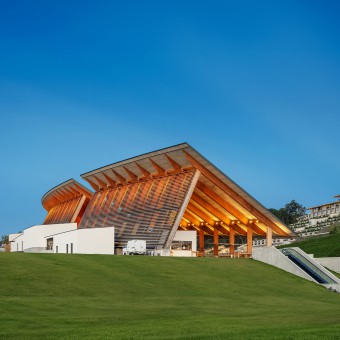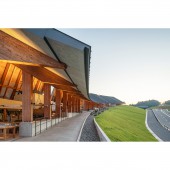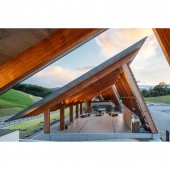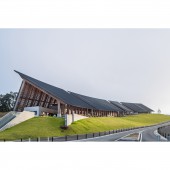
| THE AWARD |
| CATEGORIES |
| REGISTRATION |
| SUBMIT YOUR WORK |
| ENTRY INSTRUCTIONS |
| TERMS & CONDITIONS |
| PUBLICATIONS |
| DATES & FEES |
| METHODOLOGY |
| CONTACT |
| WINNERS |
| PRESS ROOM |
| GET INVOLVED |
| DESIGN PRIZE |
| DESIGN STORE |
| THE AWARD | JURY | CATEGORIES | REGISTRATION | PRESS | WINNERS | PUBLICATIONS | ENTRY INSTRUCTIONS |
Mrc Vison Market by Tomoya Akasaka |
Home > Winners > Design #151645 >Interview |
 |
|
FS: What is the main principle, idea and inspiration behind your design?
TA: The design philosophy behind Marché VISON is a multi-layered concept that integrates architectural innovation with natural elements, cultural reverence, and environmental sustainability. Here's a summary of the 8 key ideas and inspirations shaping this unique project: 1/ Expansive Roofs: Symbolizing humanity's place within the natural cycle of rain and sunshine, the design features large, expanding roofs with a three-dimensional curve extending along the ground. The continuous eaves and gutters are designed to show the dynamic rain curtain. 2/ Wooden Frames: The expansive roofs are supported by a continuous wooden frame, inspired by the tunnel-like series of torii gates at Akone Yashiro Shrine. This shrine is dedicated to prayers for bountiful harvests, plentiful catches, and thriving commerce, making it an ideal inspiration for a facility showcasing Mie Prefecture's production. 3/ Sequence: After exiting the highway and making a gentle uphill turn, the expansive roofs in continuity with the earth come into the open sky view. This beginning makes guests aware of the sky, while the 200-meter-long structure heightens visitors' awareness of the earth, responding to the landscape's scale. Serving as the initial interaction point for visitors from the city, the design integrates with the natural environment, marking a symbolic entry to VISON. It strategically guides visitors, fostering exploration and environmental engagement. 4/ Dual Temporal Layers: Acknowledging the inevitability of commercial evolution, the design separates commerce and landscape timelines. Even though the design of dozens of stores may change one after another over the course of years, the roofs and wooden frames will remain the same. The unpainted wood will evoke the accumulation of time and will be in harmony with the slowly changing nature. By distinguishing the expansive roofs from the compact areas below, it aims to capture the enduring beauty of nature while accommodating the change of store design, allowing for an adaptable and timeless space. 5/ Skeleton of the Landscape: VISON was developed with the aim to apply height differences wherever possible in order to create a mountain scenery. Marché VISON also takes on this direction and intends to acquire the richness of the emerging three-dimensional scenery. While the structure is divided into four buildings in the longitudinal direction, the stepped slabs are connected with slopes to continuously align the frame pitch in order to fortify the impression of an en suite facility. Transverse to the long side, the gradient that continues from the terrain to the grand roofs guides the eyes to the sky, creating a lively flow. 6/ Homeland Scene: Facing the expressway, the exterior features Mie Prefecture wood louvers, offering a dynamic view that captures local natural splendor. This is intended to create and showcase a luminous drama that can be seen from cars. In particular, we carefully presented the comfort of the hours when the mountain range blurs into the evening sky. The lights that resemble those leaking from houses remind people of warmth and harmonize with the darkening mountains. People of the next generation protect and foster homeland scenes and share that value with guests from faraway. We hope for such virtuous cycle. 7/ Intermediate Zone: Marché VISON acts as a bridge between indoor and outdoor spaces under its expansive roofs, promoting interaction with the local climate and nature. The idea is for people to enjoy the view of the sky and the mountain landscape along with seasonal foods. We wanted to embrace the seasonal physical sensations that tend to be forgotten in our world where closed-type shops and online shopping has become commonplace. This design also minimizes energy use for climate control while highlighting seasonal offerings. 8/ Genius Loci: Despite significant alterations to the natural landscape, the project seeks to preserve the genius loci, or the protective spirit of the place. Instead of building concrete edifices pursuing economy in the narrow sense, we aimed to create a unique landscape that connects with the regional environment and offers a sense of affluence over generations. With such a mindset, we pursued a way to design and create Marchテゥ VISON so that it brings out the best of the natural environment. We took particular care in the elements where the common practice of commercial facilities may clash with the ideals of the area’s scenery, such as signs and lighting. Overall, Marché VISON embodies a profound respect for its natural and cultural setting, leveraging architectural expression to create a space that is both innovative and deeply rooted in local identity and environmental responsibility.
FS: What has been your main focus in designing this work? Especially what did you want to achieve?
TA: The primary focus in designing Marché VISON has been to foster a deep connection between the environment, the local community, and the broader sphere of food culture. We aimed to create a venue that not only highlights local produce and culinary innovation but also serves as a vibrant gathering place for learning, sharing, and celebrating the rich heritage of Mie Prefecture. In line with this, an essential part of our vision for Marché VISON is to serve as a catalyst for regional innovation and educational opportunities. This includes collaborating with local high schools to host events that engage students in the agricultural and culinary arts, providing them with practical experiences and insights into potential career paths. Moreover, by inviting chefs to introduce new specialties, we intend to create a dynamic platform for culinary experimentation and discovery, further enriching the local food culture and agritourism. This approach underlines our commitment not only to architectural and environmental sustainability but also to nurturing the educational and social fabric of the community. Through Marché VISON, we strive to create a meaningful impact on the region's development, encouraging a new generation to explore and contribute to the local culture and economy.
FS: What are your future plans for this award winning design?
TA: My vision for Marché VISON within the development project is to see it evolve as a central hub for regional innovation and collaboration. Ideally, Marché VISON would extend its role as a platform to showcase innovative dishes utilizing local ingredients, promoting not just the local cuisine but also acting as a catalyst for agritourism by encouraging visits to the origins of these ingredients. Furthermore, it would be meaningful if it could enhance its contribution to regional development and the preservation of cultural heritage through collaborative events with local institutions. I hope that the design of Marché VISON can symbolically embody these initiatives, marking it as a landmark of community engagement and sustainable development within the development project. However, as a designer, my role is to provide the vision and hope for these outcomes, understanding that the realization of such goals primarily lies in the hands of those who manage and operate the facility post-construction.
FS: How long did it take you to design this particular concept?
TA: The design of Marché VISON took nine years, as it was conducted in parallel with the area development of VISON. Unlike typical architectural projects that begin with a predetermined site, in this case, we started entirely from the ground up, without any pre-existing roads or infrastructure. Our initial step involved extensive planning on how to develop the terrain itself, which included mountainous areas. Although time-consuming and labor intensive, this comprehensive approach to both architectural and infrastructural elements helped to establish a close relationship between architecture and landscape.
FS: Why did you design this particular concept? Was this design commissioned or did you decide to pursuit an inspiration?
TA: The project initiated at the request of the Taki local government, aimed at area development with a focus on food and health. On our initial visit in 2013, the site's vast size—equivalent to two Tokyo Disneylands—and 200-meter elevation presented a daunting prospect due to the potential significant environmental impact. However, the opportunity to contribute to a legacy for future generations, transcending mere efficiency at the cost of environmental degradation, compelled us to participate. We committed to designing a project that would minimize environmental harm. This was driven by our aspiration to transform the area into a symbol of hope and regional distinction, prioritizing the land's intrinsic value over mere efficiency. Marché VISON, within the broader VISON development that includes a variety of buildings and roads, serves as a direct sales market for local produce and stands as a particularly emblematic facility. Our design philosophy celebrated the landscape's unique qualities, akin to how fine cuisine accentuates the best of its ingredients, aiming to cultivate a strong sense of connection and belonging. This vision aimed not only to support child development but also to attract visitors from afar, contributing to regional revitalization. We recognized the importance of creating scenic value that integrates architecture, industry, tourism, and human resource development comprehensively.
FS: Is your design being produced or used by another company, or do you plan to sell or lease the production rights or do you intent to produce your work yourself?
TA: Marché VISON is not merely a concept, but a realized component of the VISON project, fully integrated into its development and serving the local community's specific needs. Currently, there are no plans to sell or lease the production rights, as the design and its implementation are uniquely tailored to the VISON project's context and objectives. We intend to oversee the production ourselves to ensure it aligns with our vision and standards.
FS: What made you design this particular type of work?
TA: Marché VISON was created as a regional collaboration platform focusing on food, designed to leverage Mie Prefecture's abundant agricultural resources and establish a hub for regional food culture. The initiative seeks to boost the local economy, promote sustainable farming practices, and enable cultural exchange and innovation. Moreover, it aims to reforge connections between the community and its culinary heritage and future prospects. Beyond serving as a mere marketplace, Marché VISON also aspires to be a pivotal component in advancing agricultural tourism within the region.
FS: Where there any other designs and/or designers that helped the influence the design of your work?
TA: The design of Marché VISON is entirely our own, rooted in a deep understanding of the regional architecture, landscape design, and the cultural importance of food in Mie Prefecture. Although the rich traditions and natural beauty of the area served as inspiration, no specific external designs or designers had a direct influence on our work. Our aim was to craft a design that harmonizes with the local environment and community, capturing the distinct essence of Mie Prefecture.
FS: Who is the target customer for his design?
TA: The target customer for Marché VISON includes local residents, tourists, food enthusiasts, culinary professionals, and anyone interested in the rich agricultural heritage and vibrant culinary culture of Mie Prefecture. We aim to attract a diverse customer base by fostering a community centered around shared interests and experiences.
FS: What sets this design apart from other similar or resembling concepts?
TA: What distinguishes Marché VISON from similar concepts is its integration into the VISON area development plan, which included developing roads and infrastructure from scratch. This approach allowed for a design that is in harmony with the landscape. More than just aesthetics, the design deeply intertwines with the local environment and culture. It fosters a connection that reflects the symbiotic relationship between humanity and nature, highlighting our bond with the earth and the cosmos. The architecture represents this profound link, situating human existence within the perpetual rhythms of nature and illustrating the cycle of life, as well as humanity’s place in the natural world. It aims to merge modern living with the timeless essence of our environment.
FS: How did you come up with the name for this design? What does it mean?
TA: Marché VISON combines 'Marché,' the French word for market, with 'VISON,' a name thoughtfully crafted to resonate with the project's underlying concept and its connection to the region. The name encapsulates the essence of an innovative and sustainable platform for local collaboration, focusing on regional food culture and health. Choosing 'Marché' signifies the project's role as a community hub, a place for selling local agricultural products, hosting food-related events, and facilitating social interactions, much like traditional markets have done for centuries. Marché VISON aspires to revitalize this communal essence in a modern context. 'VISON' is inspired by the Japanese word '美村' (bison), meaning 'beautiful village,' and is combined with the word 'vision.' This fusion reflects the project's ambition to blend a vision of modern living with the timeless beauty and cultural richness of the region. By incorporating phonetic elements of French, it also nods to the elegance and sophistication associated with French markets and cuisine. Therefore, the name Marché VISON is more than just a label; it is a representation of the project's goals to foster a deep connection with the local environment and community. It stands for the commitment to creating a landmark that embodies the project's ideals and aspirations, bridging tradition with innovation.
FS: Which design tools did you use when you were working on this project?
TA: For the design process of Marché VISON, we utilized a diverse set of tools, including hand-drawn sketches for initial concepts, as well as sophisticated software such as Rhinoceros for 3D modeling and Grasshopper for algorithmic design. These tools allowed us to meticulously explore spatial configurations, fine-tune structural designs, and ensure the project's harmonious integration with the natural landscape. By leveraging Rhinoceros and Grasshopper, we were able to experiment with complex forms and sustainable design solutions, reflecting the unique character of the VISON project and its surroundings.
FS: What is the most unique aspect of your design?
TA: The most distinctive feature of our design for Marché VISON is, without a doubt, the expansive roofs. These roofs are not only architecturally significant but also symbolize the profound connection between humanity and nature. They are designed to capture and channel rainwater back to the earth and to reflect sunlight into the sky, thus embodying the perpetual cycle of nature's bounty. This design element vividly represents the cycle from the heavens to the earth and back, establishing a direct connection between the constructed environment and the natural world. By embedding this cycle into the core structure of Marché VISON, we underscore the project's dedication to sustainability and its reverence for the natural rhythms of the environment.
FS: Who did you collaborate with for this design? Did you work with people with technical / specialized skills?
TA: The design of Marché VISON was the result of a collaborative effort that involved architects, road designers, civil engineers, and structural engineers. This interdisciplinary approach ensured that the project benefited from a broad spectrum of expertise, culminating in a design that is both innovative and deeply ingrained in local traditions.
FS: What is the role of technology in this particular design?
TA: Technology enabled the fine-tuning of various variables to optimize gradients for cars, wheelchairs, strollers, and pedestrians. Real-time visualization was pivotal, offering intuitive insights to engineers and aiding in the decision-making process. Moreover, the design emphasized the 'mountain experience,' striving to evoke the sensation of being in the mountains for visitors. Utilizing algorithms facilitated comprehensive planning, taking into account complex factors and allowing for the exploration and meticulous consideration of landscape patterns beyond what could be achieved with traditional plan and section views alone. This approach was crucial for the cohesive integration of landscape, streetscape, and architectural design across the project.
FS: Is your design influenced by data or analytical research in any way? What kind of research did you conduct for making this design?
TA: E-commerce's growing popularity, as exemplified by Amazon, has led to a decline in foot traffic to brick-and-mortar stores. Our client's marketing research, encompassing a commercial area survey, a customer survey, and a competitive analysis, highlighted this trend. This research uncovered a growing disconnect between consumers and the origins of their food. In response, we aimed to design a space that rekindles the connection between the food we consume and the environment where it is produced.
FS: What are some of the challenges you faced during the design/realization of your concept?
TA: Designing Marché VISON presented several challenges, notably integrating the facility with the region's unique natural and cultural landscape while maintaining its commercial viability. One significant challenge was the balance between the project's innovative architectural features and practical needs like accessibility and traditional building practices. A core concept we grappled with was the 'Dual temporal layers'—balancing the slow-changing landscape with the need for the commercial spaces to remain dynamic and fresh. Innovations were needed to accommodate both the natural growth cycles and the evolving commercial demands, which led us to design distinct areas such as the expansive roofs and small units beneath for flexibility and adaptability. Additionally, competing with the convenience of e-commerce required us to rethink the traditional shopping experience. We aimed to create an inviting landscape that encourages visitors to connect with the environment and the origins of their food, making the act of shopping a memorable experience.
FS: How did you decide to submit your design to an international design competition?
TA: I decided to submit Marché VISON to an international design competition, motivated by my ambition to showcase the project's integration of local culture, sustainability, and economic viability on a global stage. Receiving feedback from industry experts was invaluable for identifying strengths and areas for improvement, which helped in my personal and professional growth. Participating provided a unique opportunity to broaden my perspective and strategically present the design philosophy and achievements behind Marché VISON, advancing my innovation goals and professional development.
FS: What did you learn or how did you improve yourself during the designing of this work?
TA: In the design process of Marché VISON, one vital lesson we learned was the necessity of thoroughly understanding the local context, encompassing not just the physical aspects but also the cultural, social, and economic dimensions. Rethinking our approach to sustainability, we embraced new perspectives on environmental conservation. Inspired by the traditional practices observed at Ise Jingu Shrine, we opted for the use of unpainted wood to harmonize building maintenance with the regional forest landscape. This choice sparked discussions about customer perceptions of natural aging in commercial settings, confronting us with the importance of valuing and communicating the beauty of natural decay over time instead of persistently maintaining a brand-new appearance. This shift in mindset allowed us to present our vision of deeply valuing the natural aging process and respecting traditional aesthetics. However, what we managed to achieve was merely the presentation of a vision. We recognize that this maintenance idea must work as part of a business cycle.
FS: Thank you for providing us with this opportunity to interview you.
A' Design Award and Competitions grants rights to press members and bloggers to use parts of this interview. This interview is provided as it is; DesignPRWire and A' Design Award and Competitions cannot be held responsible for the answers given by participating designers.
| SOCIAL |
| + Add to Likes / Favorites | Send to My Email | Comment | View Press-Release |





